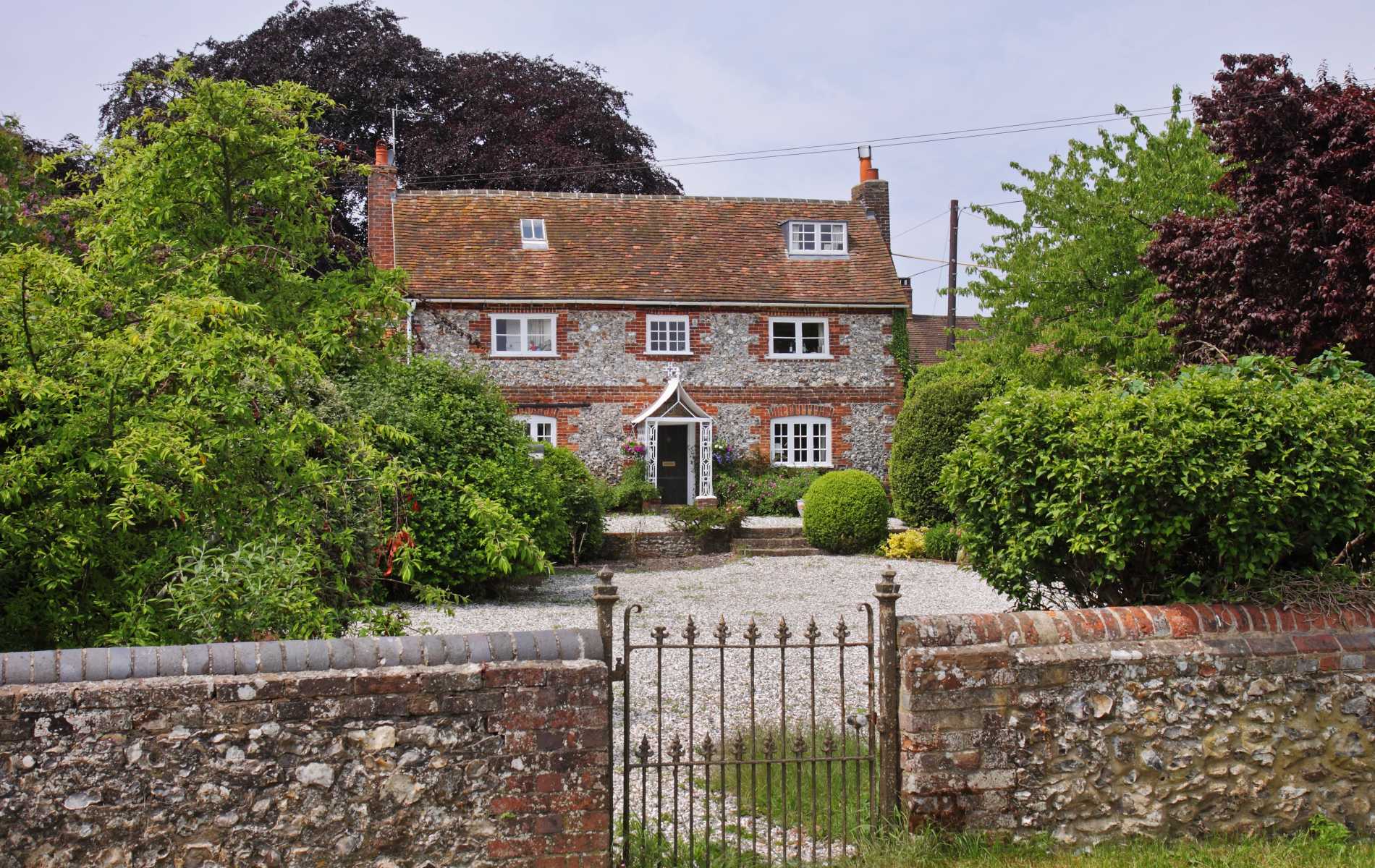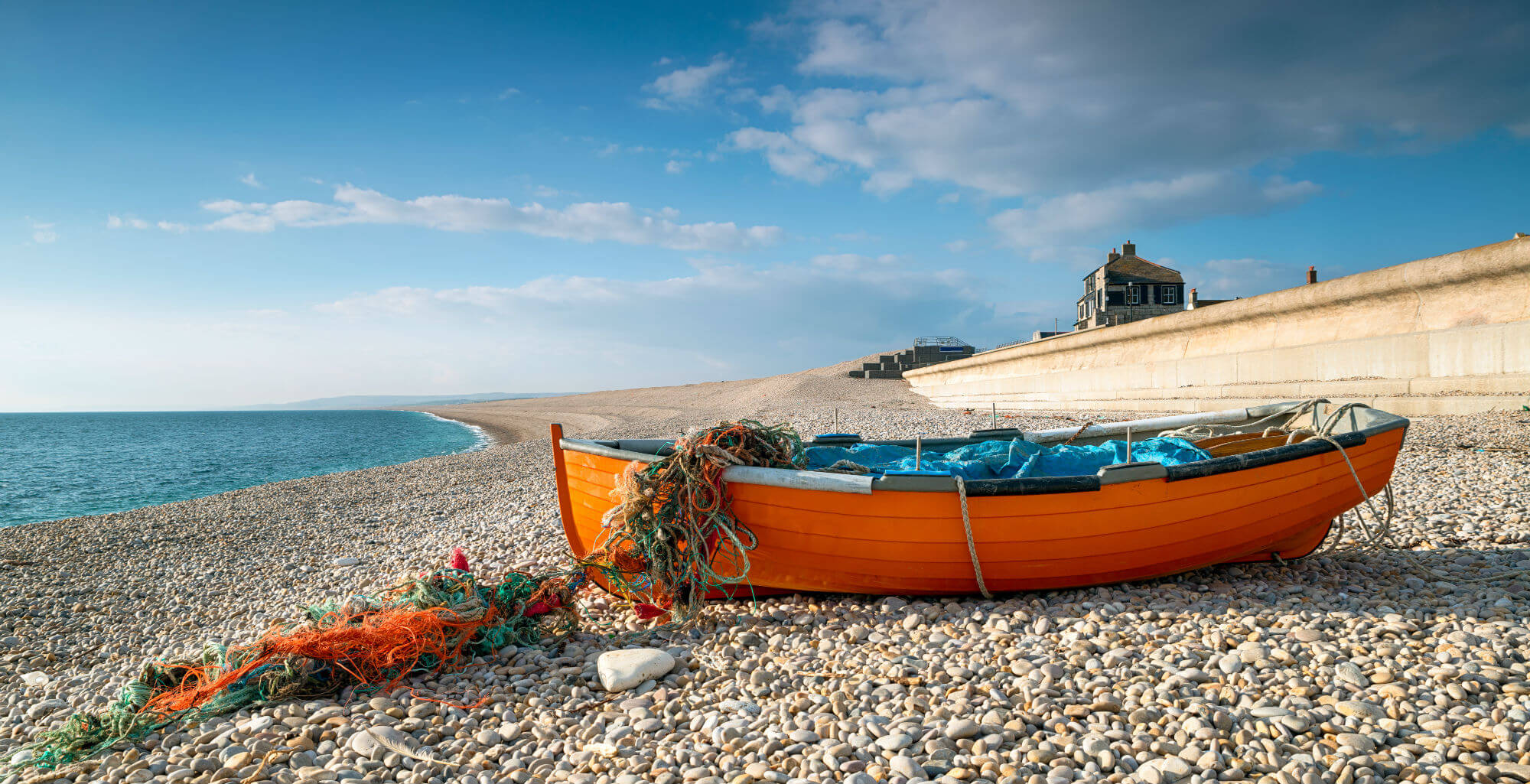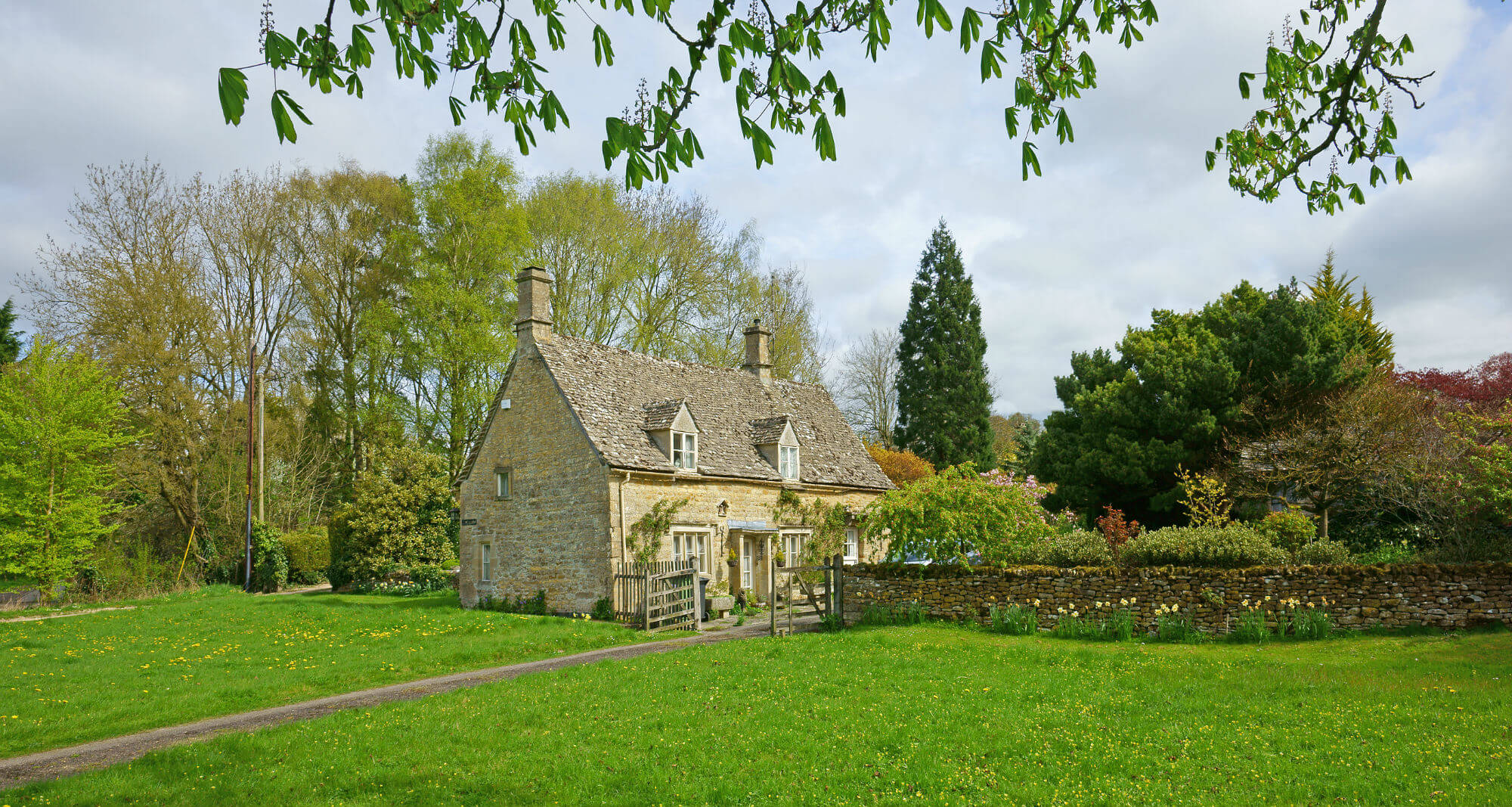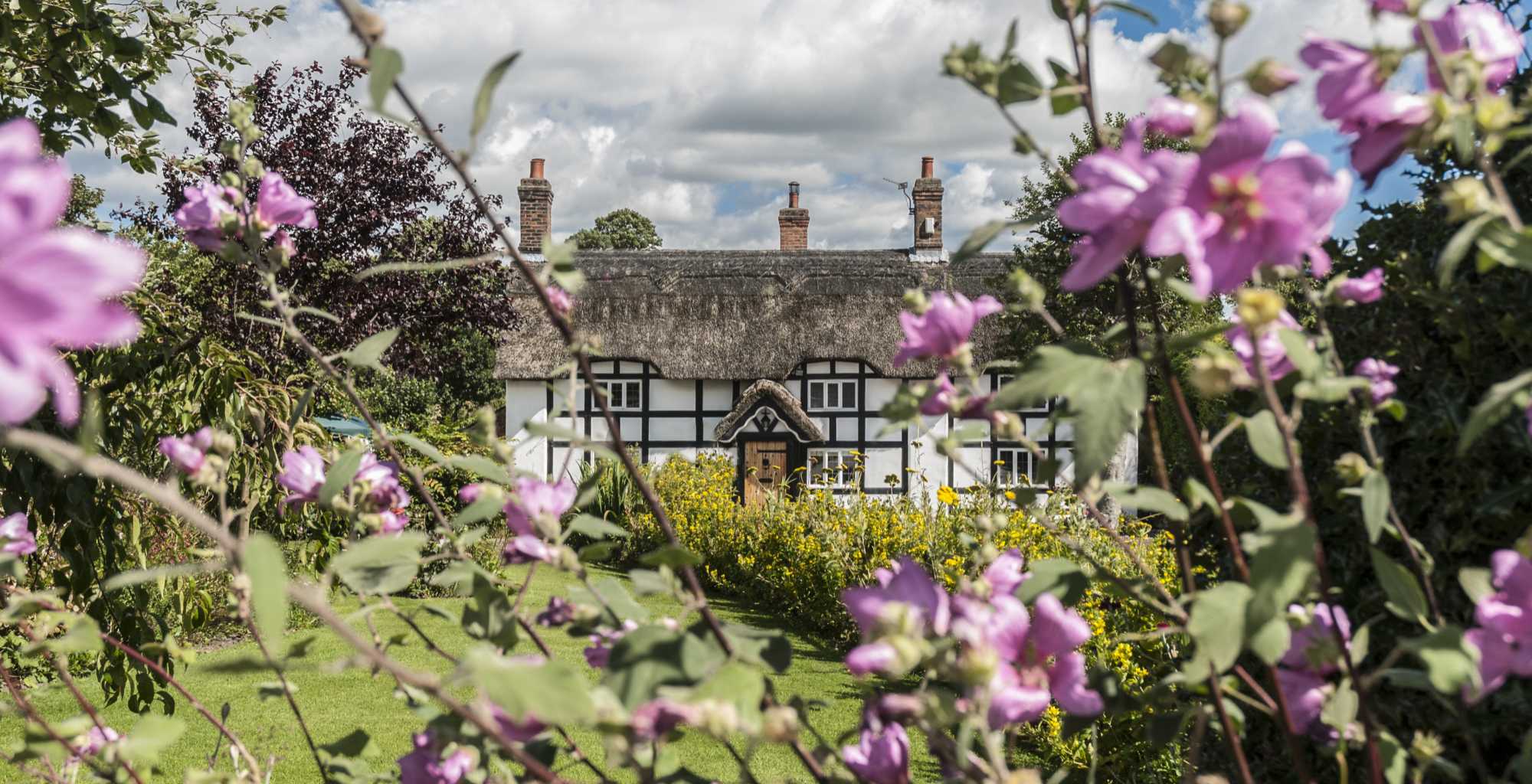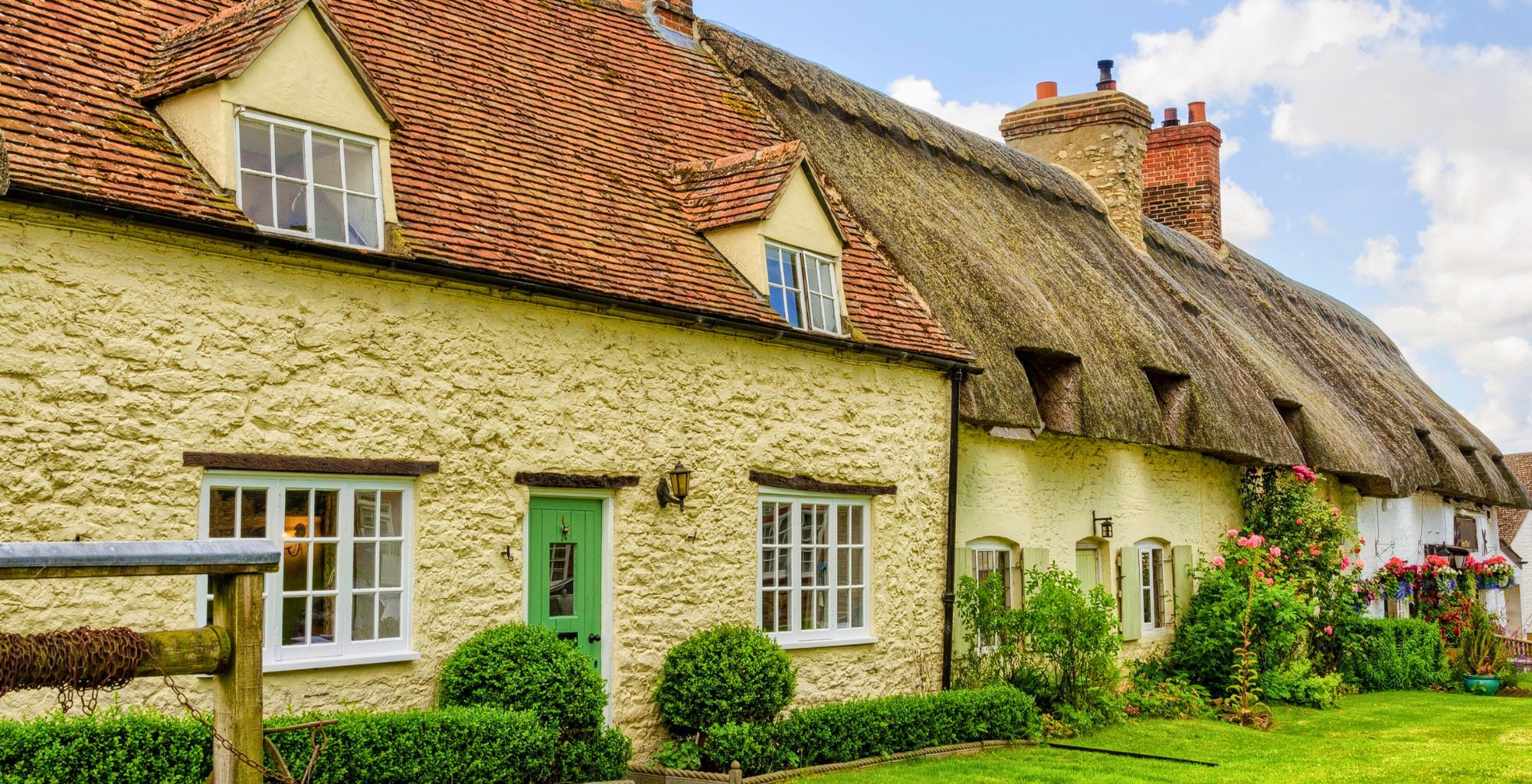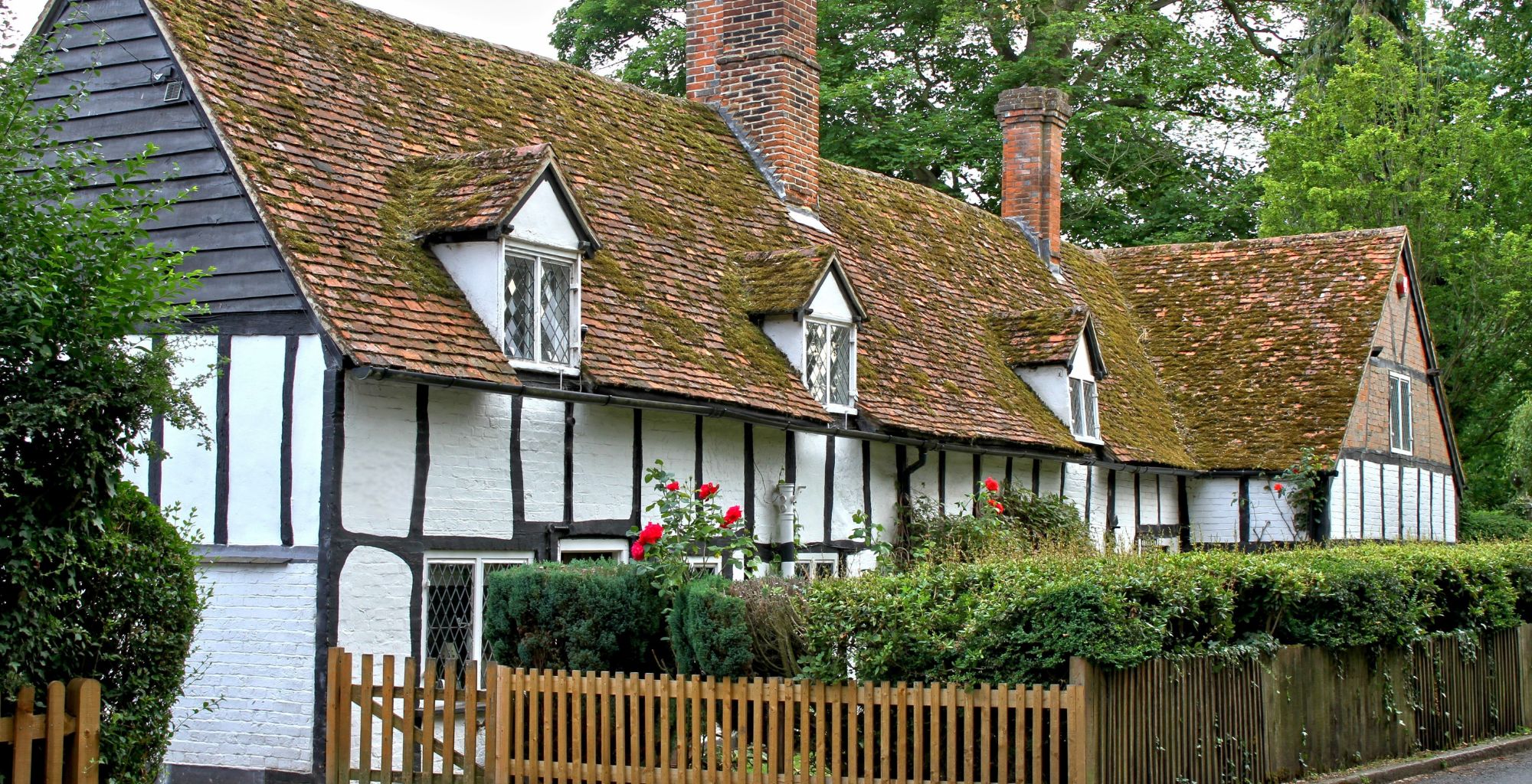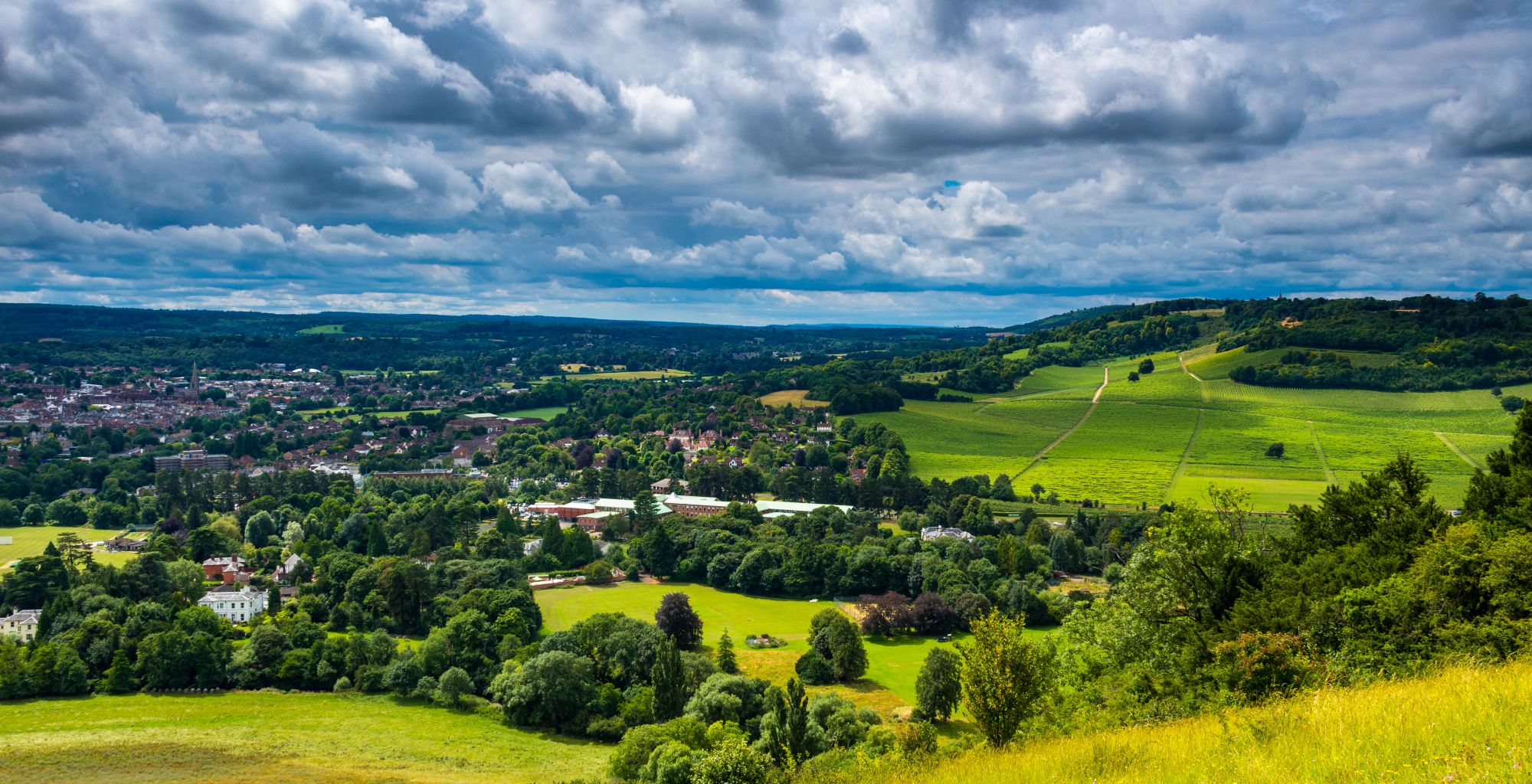Are you considering a move to the North West and want to know where the best places to live...
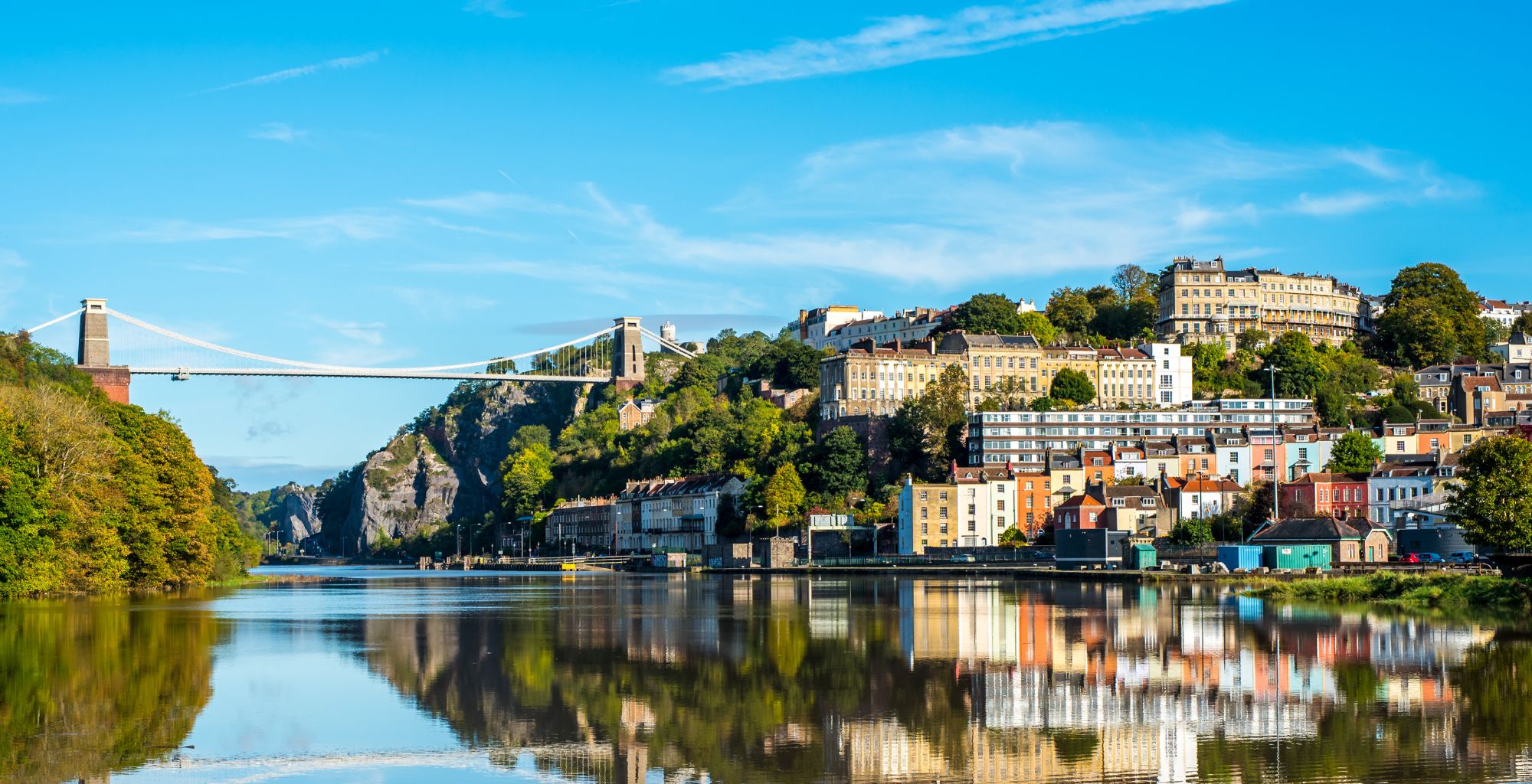
The 20 best places to live in the South West
Where are the 20 best places to live in the South West of England?
From tranquil beaches to bustling cities and towns, England’s largest region offers something for everyone.
Here are our top 20 places to live in the wonderful South West region.
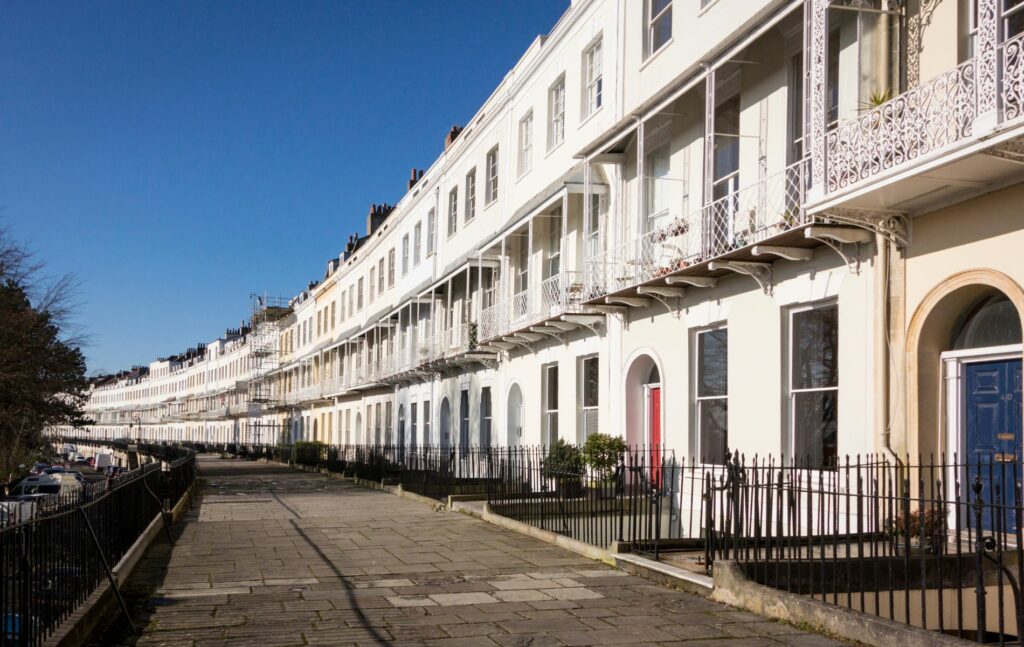
1. Clifton Village, Bristol
Key facts about Clifton:
- Education: The City of Bristol and the villages surrounding it offer more than the usual number of good schools. There are several highly-regarded primary schools, and in the state sector, exceptional schools such as Bristol Cathedral Choir School and Colston’s Girls’ School (both academies) catering to 11 to 18-year-olds;
- Private schools: There are 13 independent schools in Bristol, including the highly-rated Bristol Grammar School and Clifton College;
- Transport links by road: thanks to its proximity to Bristol, Clifton is strategically situated, within easy reach of major motorway networks. The M32, for instance, connects Bristol with the M4 motorway (east to London and west to South Wales) and the M5 motorway north to the Midlands and south to southwest England. The 118-mile (190 km) drive to London takes around two and a half hours;
- Travel by train: The fastest journey time from Bristol’s mainline Temple Meads railway station to London Paddington is one hour and 20 minutes.
Is Clifton Village a good place to live?
Bristol is the biggest city in the south west of England, with a population of almost half a million.
Clifton is a beautiful historic place to live with many independent stores and stunning architecture.
Located at the top of Bristol, many homes in Clifton enjoy far-reaching views and ready access to the nearby open green space of The Downs.
If you’re looking for somewhere rural to live, just the other side of the suspension bridge nearby Abbots Leigh is probably one of the most sought-after villages on the outskirts of Bristol.
The area is known for its substantial detached homes and the leafy green spaces of Leigh Woods Nature Reserve.
2. Chipping Sodbury, Gloucestershire
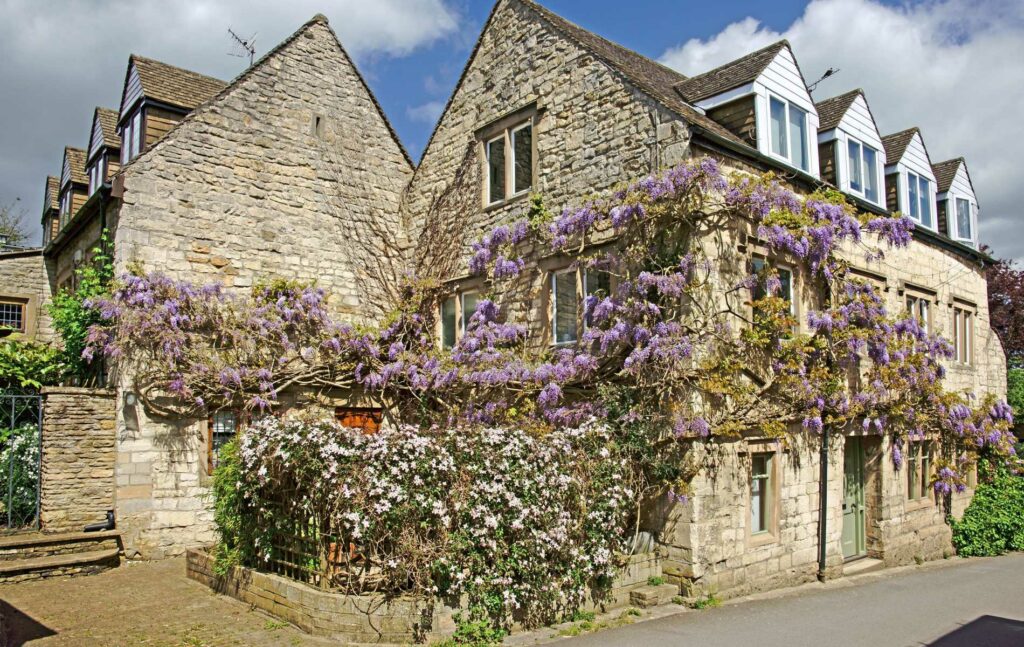
Key facts about Chipping Sodbury:
- Education: of the many quality primary schools in Chipping and the nearby outskirts of Bristol, a stand-out example is Old Sodbury Church of England Primary School. Just 1.3 miles (2 km) away in the village of Yate, the secondary Brimsham Green School is well-regarded;
- One of the oldest surviving schools in England, Katharine Lady Berkeley’s School – founded in 1384 – is just eight and a half miles (13.6 km) away in Wotton-under-Edge;
- Transport links: Although it is an ancient market town in a relatively secluded part of the county of South Gloucestershire, Chipping Sodbury is well-connected thanks to its proximity to the major M4 motorway (about three miles or five km to the south), which travels due east to London and west to Bristol and South Wales. Driving time (108 miles, 174 km) to London is around two hours;
- Travel by train: The journey by rail to London involves boarding at Yate and one or two platform changes for roughly a two-hour journey to London Paddington.
Why live in Chipping Sodbury?
Chipping Sodbury has played its part as a strategic market town since medieval times because it stands at the crossroads of the main routes between Bristol, Oxford, and London.
That strategic convenience is today enhanced by its ease of access to the main east-west motorway, the M4.
Situated on the southern edge of the Cotswolds, the attractive open countryside remains nearby, while Bristol offers all the amenities and recreation of a big city – little wonder that many describe living in Chipping Sodbury as having the best of both worlds.
3. Frampton on Severn, Gloucestershire
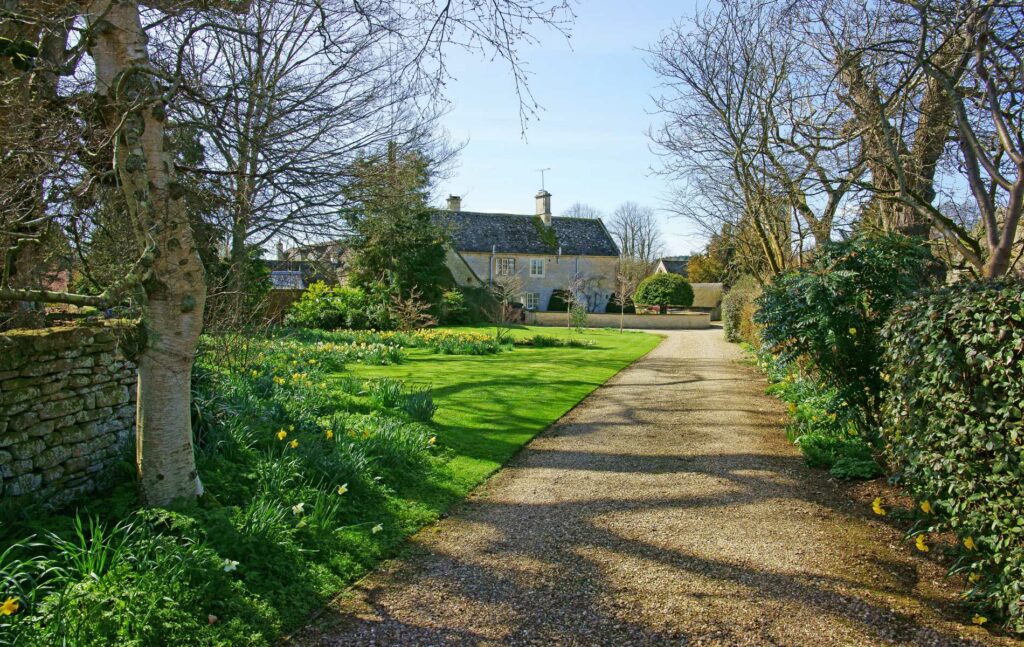
Key facts:
- Education: there are three state primary schools closest to Frampton on Severn, Eastington Primary School, just two and a half miles (four km) away, is notable for its high standards. Nearby Marling School, for boys aged 11 to 18, is also highly-regarded as is the girls’ grammar school Stroud High School;
- There are also eight or so fee-paying private schools within easy reach;
- Transport by road: with the banks of the River Severn on one side, the M5 motorway on the other, and the county town of Gloucester just 10 miles to the north, Frampton on Severn is especially well-connected. The 108-mile (174 km) drive along the M4 to West London takes just a shade over two hours, while the driving time to London’s Heathrow Airport is only one hour and 48 minutes;
- Train connections: For rail services, you need to travel the six miles (10 km) to Stroud and then catch one of the many daily trains to London Paddington – a journey time that can be as fast as just one hour and 23 minutes.
Why move to Frampton on Severn?
Frampton is a small village with a population of around 1,400.
It is a village steeped in history and occupies an attractive location, on the edge of the Cotswolds and on the banks of the River Severn.
It is an ideal hamlet for families looking for a taste of country living, yet close to all the amenities offered by the City of Gloucester and with London still within easy reach.
4. Frome, Somerset
Key facts about Frome:
- Education: the small town of Frome boasts five primary schools including the highly-regarded Berkley Church of England First School. There are also reputable state secondary schools including Frome Community College (some 1,200 pupils aged 13 to 18) and Oakfield Academy (co-educational ages 9-13);
- Private schools: The independent day and boarding school for girls aged 3 to 18, Bruton School, has an excellent academic record and is just 11 miles (18 km) from Frome. Co-ed Kings School is also in Bruton and is a popular local choice;
- Transport links: Frome railway station, which opened in 1850, is one of the oldest still in operation in the UK. Great Western Railway services cover the 94-mile (152 km) journey to London Paddington in an average time of one hour and 38 minutes;
- Travelling by car, and making use of the M3 motorway for most of that journey, the distance to London is covered in around two hours.
Why live in Frome?
In 2019, Frome was judged by the Sunday Times newspaper as one of the best places to live in the south-west of England – with the town earning the description of “free-spirited” and “pretty”.
It lies in the eastern part of the county of Somerset and lies at the heart of a predominantly rural community – once the thriving hub of the local wool and cloth industry.
Its appeal continues to lie in that rural setting, yet it’s close to the urban centres of Bath, Bristol, and not too far from London in relative terms.
5. Sherston, Wiltshire
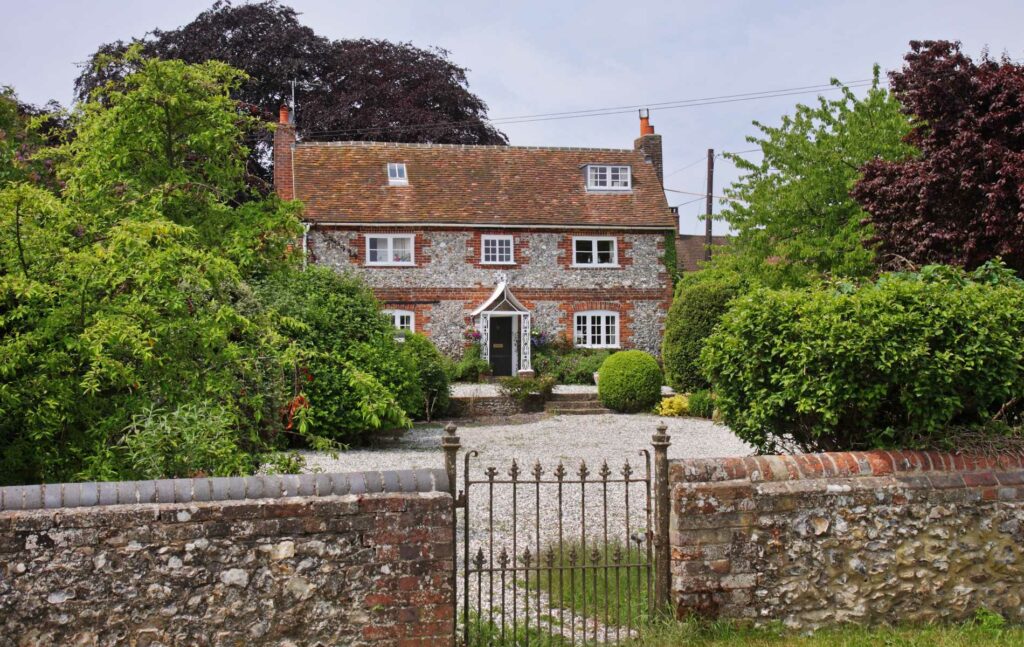
Key facts about Sherston:
- Education: popular schools include Sherston Church of England Primary School and nearby Luckington Community School. The highly-rated state secondary Malmesbury School is just five miles (eight km) away;
- Private education: One of the country’s leading independent schools, Marlborough College is just 30 miles away;
- Transport links: Sherston is in the northwest corner of the county of Wiltshire, close to the border with Gloucestershire. The ancient Roman road, the Fosse Way, runs to the southwest. Rather more important in today’s network of motorways, however, Sherston is only some five miles or so (eight km) north of the major east-west M4, giving direct access to London in the east and South Wales to the west. The 100 miles (162 km) to London can be driven in approximately one hour and 49 minutes;
- Train connections: The nearest railway station for trains to London Paddington is from Chippenham – about 11 miles (17.5 km) away – with journey times of around one hour and 17 minutes.
Why move to Sherston?
Not only is the village situated in the Cotswolds, but it also has the best pub in the Cotswolds (The Rattlebone Inn), according to a post on TripAdvisor.
Sherston is regularly named in best villages lists for its beauty and tranquillity.
6. Wye Valley
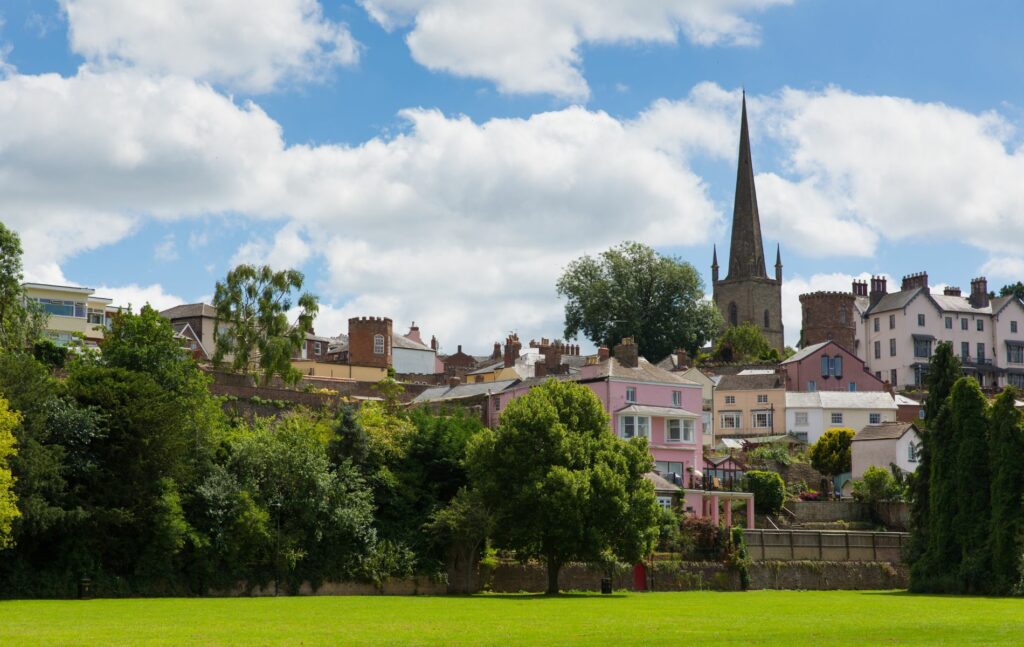
Key facts about the Wye Valley:
- Education: At the head of the valley, Hereford Sixth Form College is highly-rated, as is the independent senior school (for 11 to 19-year-olds) Hereford Cathedral School;
- Primary Schools: There are seven primary schools in and around Ross-on-Wye – all of them well-regarded, as is the main secondary school, John Kyrle High School and Sixth Form Centre Academy. In Chepstow, at the mouth of the River Wye, there are three exceptional primary schools, plus the reputable Wyedean School and Sixth Form Centre;
- Transport links: As it winds its way through the counties of Herefordshire, Gloucestershire, and Monmouthshire, the Wye Valley forms a border between England and Wales. The major town in the north of the valley is Hereford, with road connections to mid-Wales and the English Midlands. The southern part of the Wye Valley, just south of Chepstow, is an important motorway crossing of the River Severn, where the M4 heads east towards London and west to South Wales. This lets you drive the 138 miles (200 km) to London in around two hours and 11 minutes;
- Train connections: There are around 32 trains a day direct to London Paddington, the journey usually taking around an hour and 45 minutes from nearby Gloucester railway station.
Why live in Wye Valley?
Throughout the length of the Wye Valley, there are countless attractive, peaceful and essentially rural towns and villages, with the whole of this river valley designated an Area of Outstanding Natural Beauty.
7. Wells, Somerset
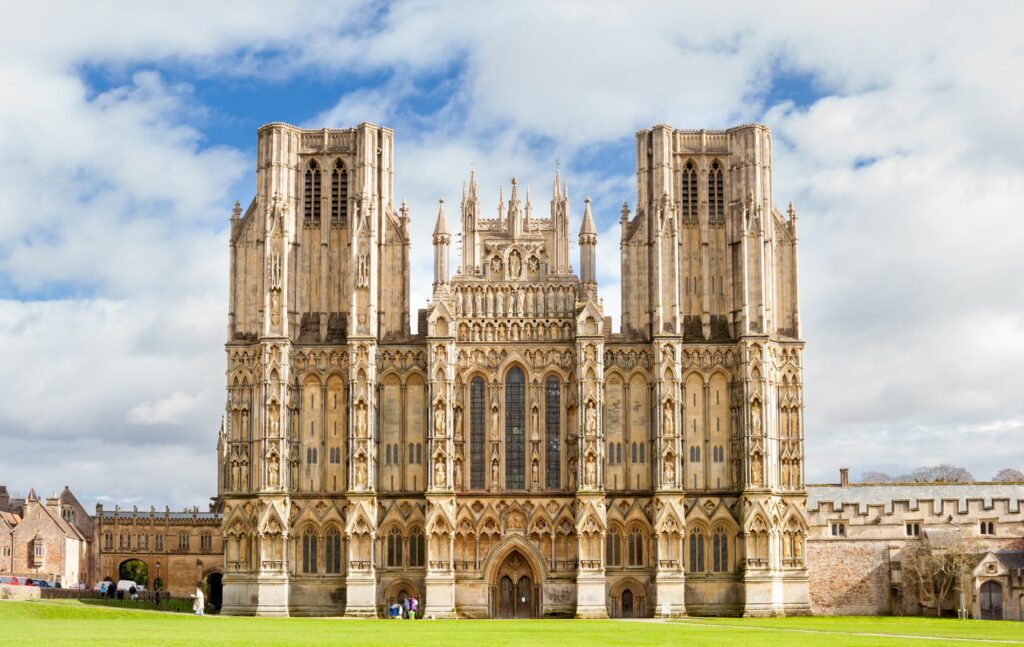
Key facts about Wells:
- Education: there are five primary schools in Wells, Horrington Primary School is a notable example. State secondary The Blue School is also well-regarded;
- Private schools: Somerset is renowned for its private schools, the city is home to Wells Cathedral School. There are many others within a short distance of Wells including Downside School and Millfield;
- Transport links: Although a major, ancient cathedral city, Wells is relatively distant from current road and rail networks. It is connected by several trunk roads to Bristol (23 miles or 37 km) to the north, Bath (22 miles or 35 km) to the northeast, and Weston-Super-Mare (21 miles or 34 km) to the northwest. The 124 or so miles (200 km) to London takes around two and a half hours to drive.
Why move to Wells?
Billed as one of the friendliest small cities (population 12,000), the Sunday Times voted Wells as one of the best places to live in the UK in 2020.
Situated between the Somerset Levels and the Mendip Hills, the city is also one of the most beautiful.
8. Backwell, Somerset
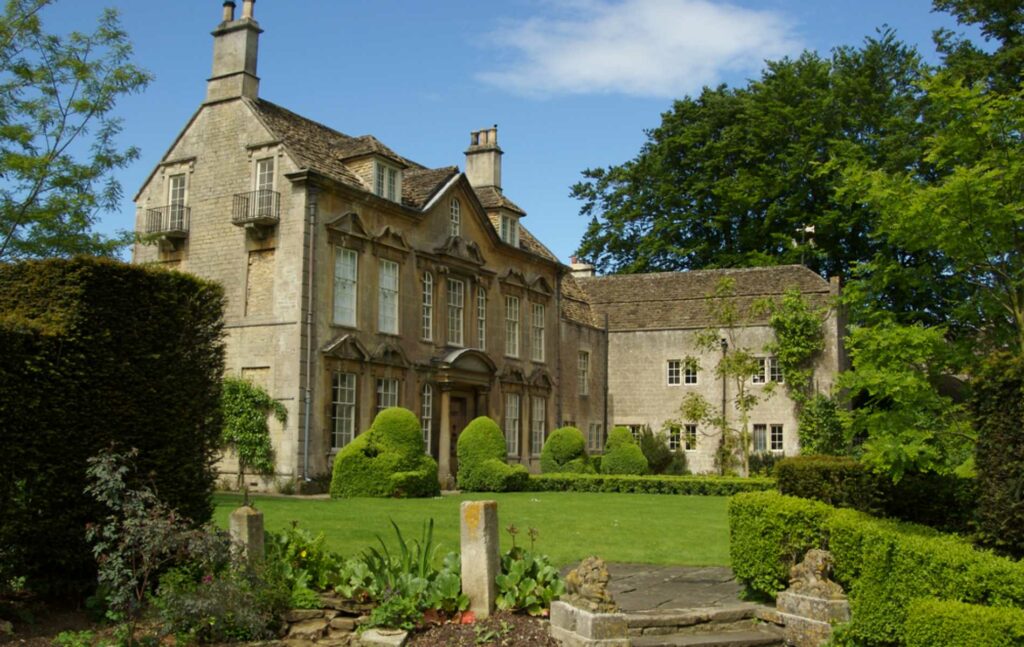
Key facts about Backwell:
- Education: there are several primary schools in the catchment area, Backwell Church of England Junior School is highly regarded. State secondary academy Backwell School, for pupils aged 11 to 18, is also popular in the area. Twelve miles to the south at Winscombe is the esteemed independent Sidcot School;
- Transport links: thanks to its proximity to the City of Bristol – seven miles (11 km) to the northeast – Backwell is well connected to the motorway network of both the M5 (north to the Midlands and south to southwest England) and the M4 (east to London and west to South Wales). Driving time to London (126 miles or 202 km) is just over two and a half hours. Trains from Nailsea and Backwell railway station can take as little as one hour and 42 minutes at peak times to reach London Paddington.
Why live in Backwell?
Situated in the leafy outskirts of Bristol, many people make the daily commute into Bristol for work – and given the fairly frequent fast trains direct to London Paddington, many also commute to London.
At the end of the working day, commuters have a home set in tranquil countryside with pubs and a village club on hand for all manner of sports and cultural activities.
9. Topsham, Devon

Key facts about Topsham:
- Education: there are seven primary schools in the catchment area for Topsham including the highly-regarded Lady Seaward’s Church of England Primary School. Less than 3 miles away is the reputable state secondary St Peter’s Church of England Aided School;
- Independent schools nearby at secondary level and sixth form are The Maynard School for Girls and the co-educational Exeter School;
- Transport links: on the banks of the River Exe between Exmouth and Exeter, Topsham benefits from the excellent road traffic connections from the latter city – specifically, the M5 motorway, which links directly to the major conurbations of the English Midlands. The 170-mile (273 km) drive to London will take some three hours and 10 minutes;
- Trains to London Paddington leave from Exeter St Davids and take around three hours and two minutes;
- Nearby Exeter International Airport has fast connections to both Heathrow and Gatwick.
Is Topsham a good place to live?
Topsham has previously been voted the best place to live in the southwest of England.
Removed, but not too far, from the hustle and bustle of the City of Exeter, Topsham earns its place on the Riviera of England as the south Devon coast is called. It can be the most beautiful place in England, even in the mid-winter.
10. Lympstone, Devon
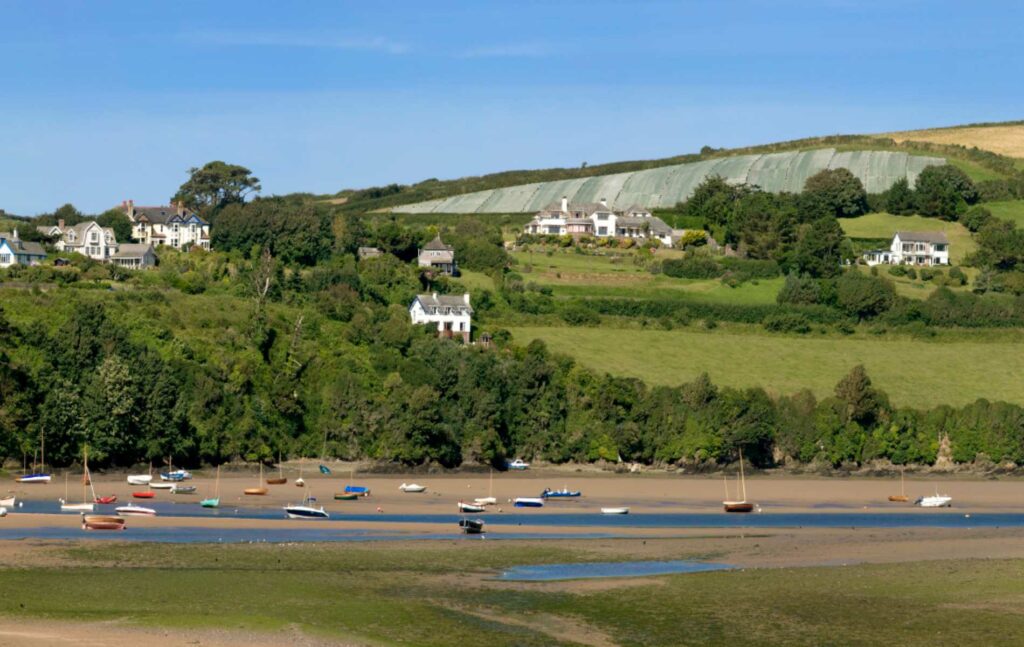
Key facts about Lympstone:
- Education: just 3½ miles (5.6 km) to the north of Lympstone is Lady Seaward’s Church of England Primary School which is highly regarded, as are the secondary Exeter College and the sixth-form college Exeter Mathematics School (which caters to students with a particular love for maths, physics, and computing); both are within easy reach;
- Transport links: as with the neighbouring residential hotspot of Topsham, Lympstone’s transport links are predominantly through the City of Exeter and from there the motorway network via the M5, the A303 and the M3. The 175-mile (282 km) drive to London will take some three hours and 13 minutes;
- Train connections: Trains run directly from Lympstone village to London Paddington with the journey taking around three hours;
- Nearby Exeter International Airport has fast connections to both Heathrow and Gatwick.
Why move to Lympstone?
On the banks of 26 tranquil miles (49 km) of the Exe Estuary and only nine miles (14.5 km) from the City of Exeter, Lympstone is bustling with all manner of activities and adventure for young families – and offers plenty of pubs and restaurants in which to relax in the evenings.
Its low crime rate, easy commuting to Exeter (or even London), and its lively community spirit make Lympstone one of the top 50 countryside places to live in the UK.
11. Thorverton, Devon
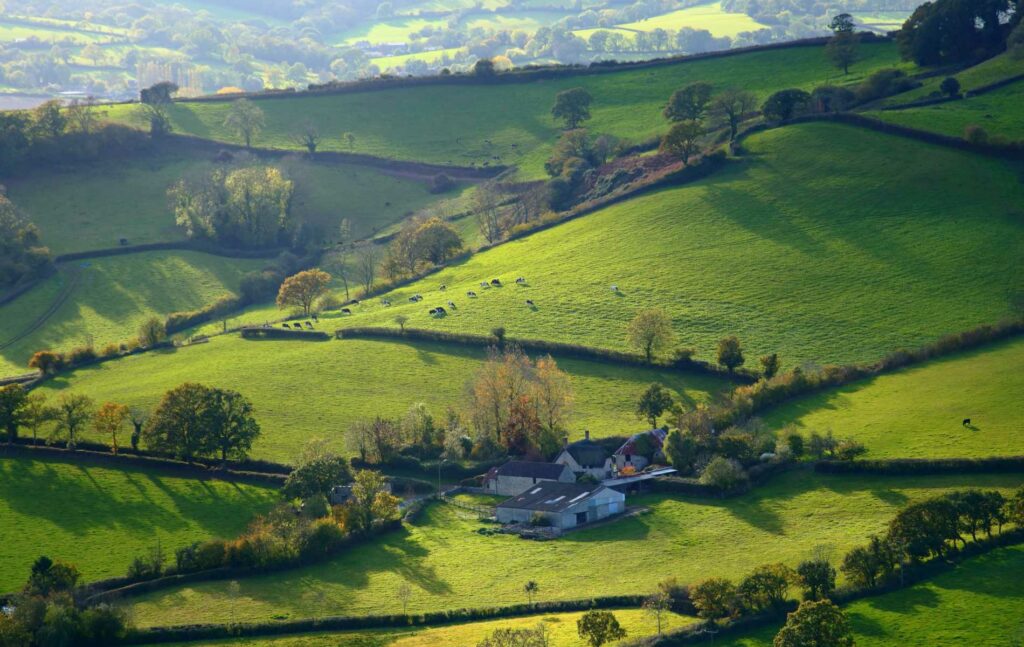
Key facts about Thorverton:
- Education: there is a reputable local village primary school, Thorverton Church of England Primary School. Another primary, The Duchy School Bradninch, just 5½ miles (9 km) away is highly regarded. The nearest state secondary school is Avanti Hall;
- Private schools: The independent St Wilfrid’s School (ages 3 to 16) and The Maynard School for girls (4 to 18 years of age) are on the nearby outskirts of Exeter;
- Transport links: just 8 miles (13 km) to the north of Exeter, and an ancient bridging point of the River Exe, Thorverton is at the hub of a cluster of Devon villages – Crediton, Cullompton and Tiverton. Exeter marks the start of the A303 trunk road, which becomes the M3 motorway, into London, some 177 miles (285 km) or around three and a quarter hours away;
- Trains to London Paddington leave from Exeter St David’s and take around three hours and 21 minutes.
Why live in Thorverton?
Thorverton was once a local fruit bowl for Devon – known for its apricot orchards.
The village is the epitome of Devon life – in many ways, it is little changed from the village known to novelist Jane Austen in her book Sense and Sensibility, which was written in 1811.
What has changed, of course, is the ease of commuting distance to Exeter and the whole of England beyond.
12. Chagford, Devon
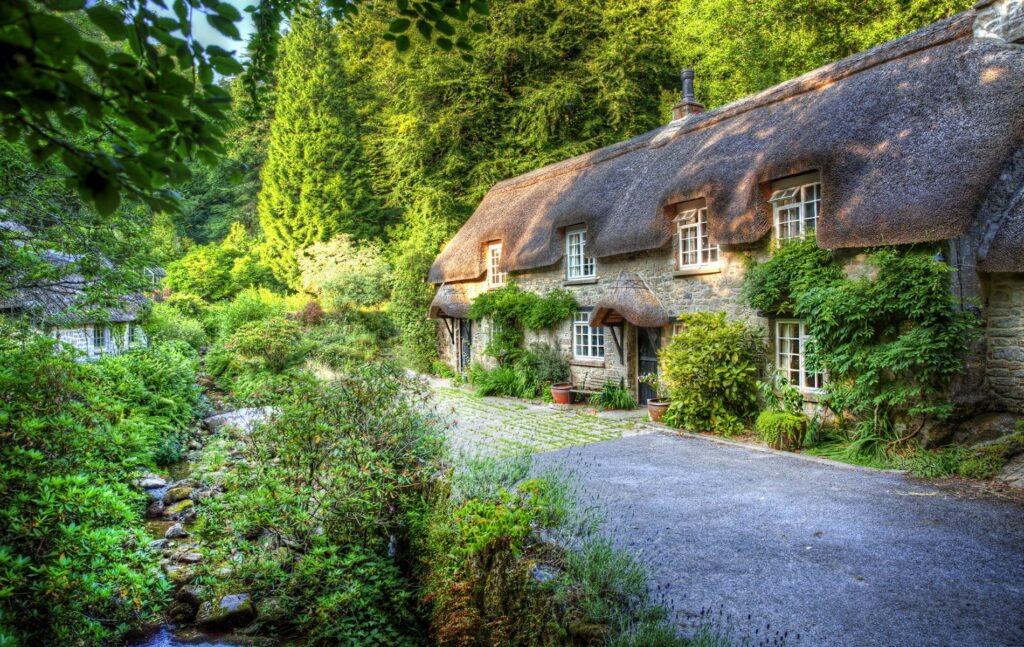
Key facts:
- Education: the local primary school, Chagford Church of England Primary School, is well regarded. The nearest state secondary school (for ages 11-18) is just 10 miles (16 km) at Okehampton College which is known for its high standards. A cluster of distinguished independent, private schools may be found in Exeter, some 21 miles (34 km) away;
- Transport links: Chagford is on the northern edge of Dartmoor National Park – inevitably, therefore, a little remote from major centres of population – even though the City of Exeter is around 21 miles away. From the city, you can join the major road and motorway networks that – via the A303 and M3 – take you the 193 miles (310 km) to London in a little more than three and a half hours;
- Train connections: Travelling to London by train also requires the short drive to Exeter St Davids railway station. The journey from Exeter to London takes around two and a half hours.
Why live in Chagford?
For several years running, Chagford has been voted one of the best places to live in the UK.
Against the rugged and magical backdrop of Dartmoor National Park, Chagford turns out to be an eminently cultivated and cultural town – home to annual festivals such as Chagfilm (for movies), Chagword (for books and literature), and Chagstock (for music).
13. Dartmouth, Devon
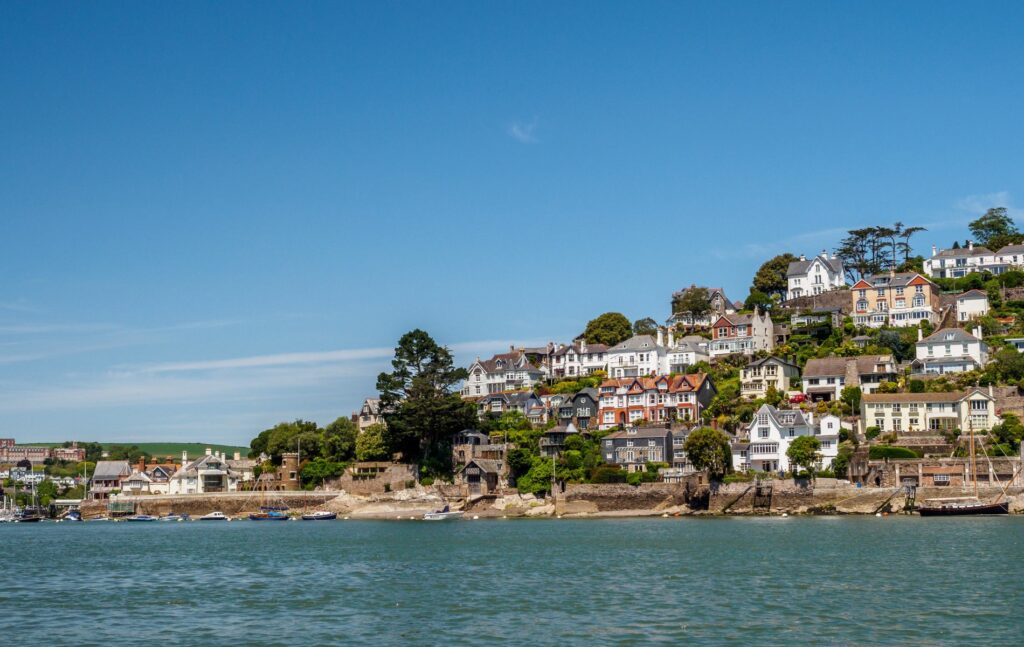
Key facts:
- Education: there are three main primary schools in Dartmouth, with Stoke Fleming Community Primary School being a notable example. Dartmouth Academy (ages 3 to 19) is a respected selective, co-educational state secondary school;
- Dartmouth is probably best known as the home of the Britannia Royal Naval College – the training college for officers of the Royal Navy and many naval officers from overseas;
- Transport links: Dartmouth is in South Devon, at the mouth of the River Dart, just off the A38 trunk road linking Exeter and Plymouth. Transport links to the rest of the country, therefore, are mainly through Exeter and its access to the M5 and M3 (via the A303) motorways. London is approximately 209 miles (337 km) away and is likely to take nearly four hours to complete;
- Train connections: Travel by train involves a 14-mile (22.5 km) drive to Totnes and from there to London Paddington – an average journey time of approximately three hours.
Why live in Dartmouth?
Dartmouth has been called the perfect place to relocate and is easily one of the most beautiful towns in the UK.
The town sits amidst the South Devon Area of Outstanding Natural Beauty – and attracts its fair share of visitors and tourists as a result.
14. Beaminster, Dorset
Key facts:
- Education: primary schools include Broadwindsor Church of England Voluntary Controlled Primary School and Parrett and Axe Church of England Voluntary Aided Primary School – which are both well-regarded, as is the state secondary Beaminster School;
- Private education: Sherbourne School – one of the country’s leading independent, fee-paying senior schools for boys, is approximately 17 miles (27 km) away in the town of Sherbourne. The Architectural Association’s School of Architecture, at Hooke Park, is located on the outskirts of Beaminster;
- Transport links: Beaminster is in the western part of the county of Dorset, some 15 miles northwest of the county town of Dorchester and midway between the towns of Crewkerne to the north and Bridport to the south. It is relatively isolated from major road networks, which means that the 144-mile (232 km) drive to London is likely to take some two and three-quarter hours;
- Train connections: For trains, you will need to travel the seven miles (11 km) to the mainline station at Crewkerne for a two and a half hour journey to London Waterloo.
Why live in Beaminster?
The town offers a simple, easy-going style of life with modern appeal.
Tucked away in the heart of rural Dorset, Beaminster offers a quiet, safe, and friendly place in which to live, far from the bustle of the modern city.
15. Bridport, Dorset
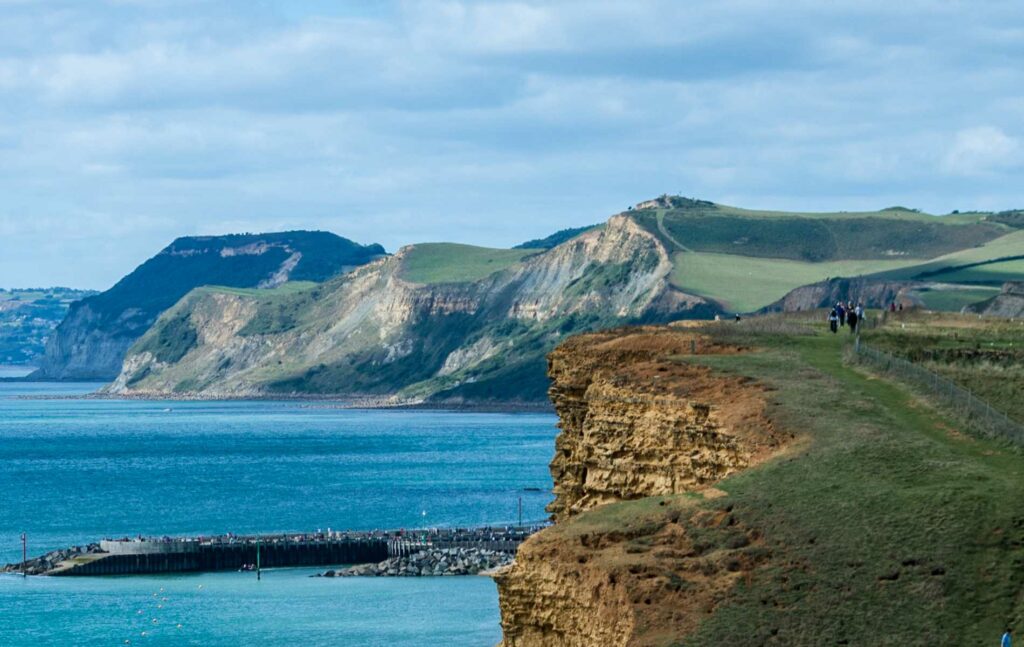
Key facts:
- Education: there are five reputable primary schools in the Bridport catchment area, The main state secondary school (ages 11 to 18), The Sir John Colfox Academy is also well-regarded;
- Private education: Some 34 miles to the northeast of Bridport, at Blandford Forum, is the nationally-acclaimed co-educational day and boarding Bryanston School;
- Transport links: Bridport is well-connected by road since it sits on the main A35 between Exeter in the west and Southampton to the east (and, from there, the M3 motorway direct to London). The 140-mile (225 km) road-trip to central London takes just over two and a half hours. For trains, you must travel the 21 miles (34 km) to the mainline station at Weymouth for services to London Waterloo.
Why move to Bridport?
Set just back from the Dorset coast at Lyme Bay, Bridport is a sought-after place to live – the idyllic countryside was described by the novelist Thomas Hardy and is part of World Heritage Site of the Jurassic Coast.
But there is also a definite modern twist and vibe to its busy streets of independent shops and laid-back eateries – earning it the nickname of London-by-the-sea.
16. Poole, Dorset
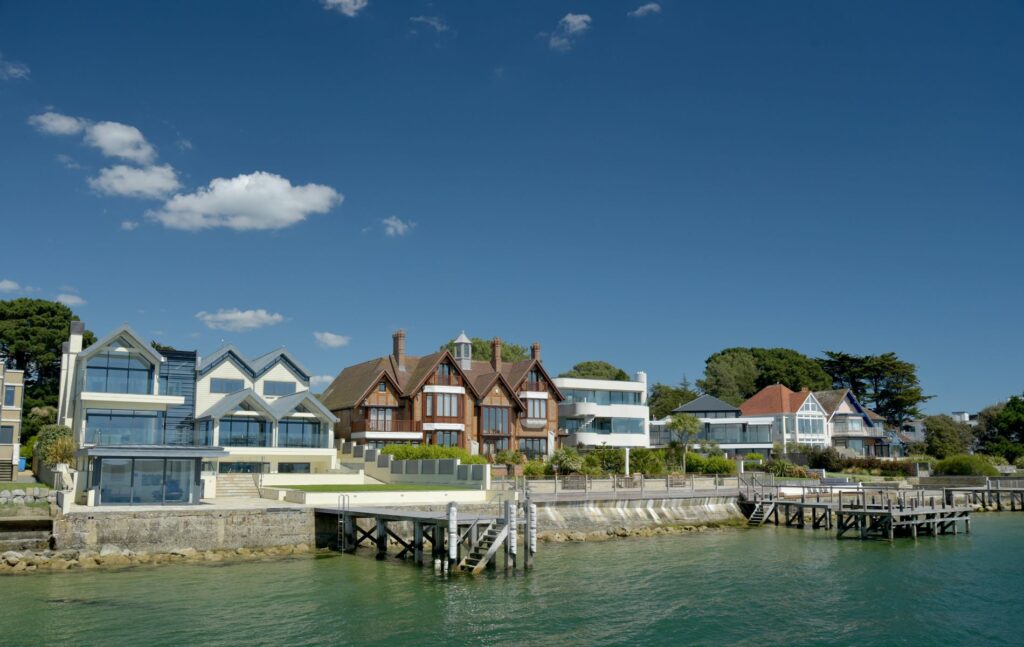
Key facts about Poole:
- Education: Canford Heath Infant School and Lilliput Church of England Infant School are highly-regarded and there are a further eight primary schools that are also reputable, as are two state secondary schools (for ages 11 to 18) – Poole High School and St Edward’s School. Bournemouth Collegiate School is a highly-rated co-educational school (ages 3 to 18) in nearby Bournemouth;
- Transport links: Poole is extremely well-connected thanks to the main A35 trunk road, which runs from Devon in the west to Southampton, and then on to London via the M3. The 108-mile (174 km) drive to central London is likely to take just over two hours. Poole is on the mainline railway to London Waterloo, with 65 trains a day, a journey that is made in just over two hours.
Why live in Poole?
Few places offer quite as much as Poole.
Not only does it allow easy access to London (by road or rail) and the Home Counties, but also the World Heritage Jurassic Coast, the beaches at Bournemouth to the east, and the New Forest National Park.
Poole is a popular place in which to live and commute to Bournemouth or London – or simply work from home.
17. Piddle Valley, Dorset – Piddletrenthide, Piddlehinton, Plush
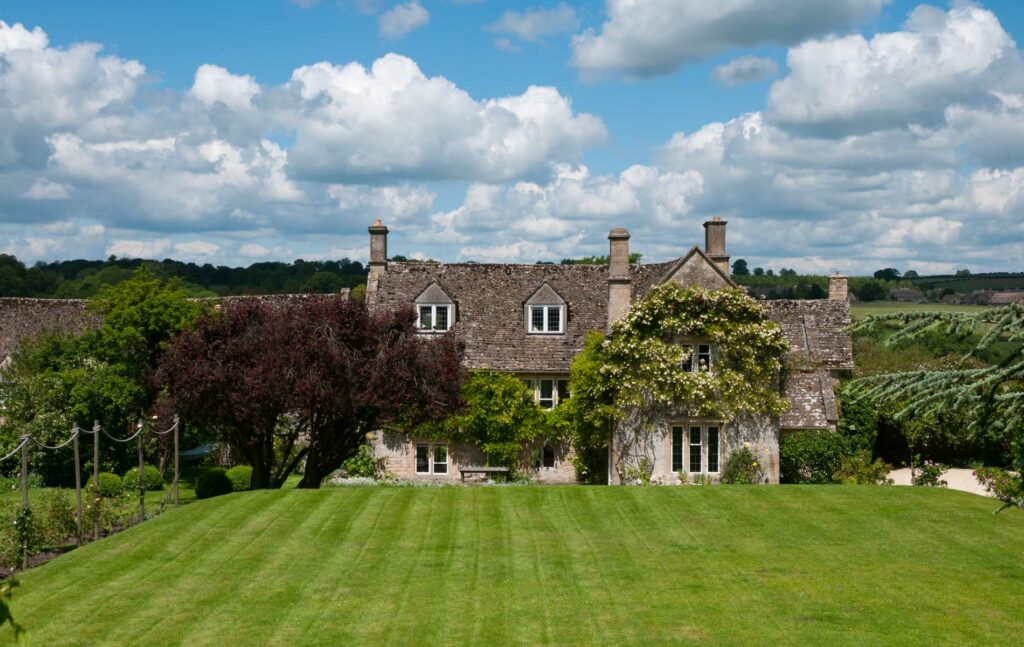
Key facts:
- Education: the Greenwood Tree Academy Trust is responsible for the management of three first (primary) schools and one middle (junior) school in the Piddle Valley. The Trust was established as recently as 2015. There are many exceptional primary schools in this part of West Dorset. Two state secondary schools in the Piddle Valley catchment area – the Woodroffe School (Lyme Regis) and Thomas Hardye School (Dorchester) – are also highly regarded;
- Transport links: the Piddle Valley runs south through the heart of Dorset but is handily bisected by the main A35 trunk road from Dorchester to Poole, and then the A31 to Southampton and the M3 motorway direct to London. The 127 miles (204 km) from Piddletrenthide to central London may be driven in around two hours and 20 minutes. Trains from Dorchester (7½ miles or 12 km from Piddletrenthide) reach London Waterloo in an average time of three hours and 13 minutes.
Why move to the Piddle Valley?
The Piddle Valley is home to a scattering of small communities, including Piddletrenthide, Piddlehinton and Plush, with a combined population of just 1,220.
The valley is tucked away from the bustle of the city and large towns, offers excellent walking country, and is Dorset at its quintessential best.
The county town of Dorchester remains not so very far away and, through that, access to the rest of southern England.
18. Nadder Valley, Wiltshire – Tisbury, Chilmark, Teffont Evias
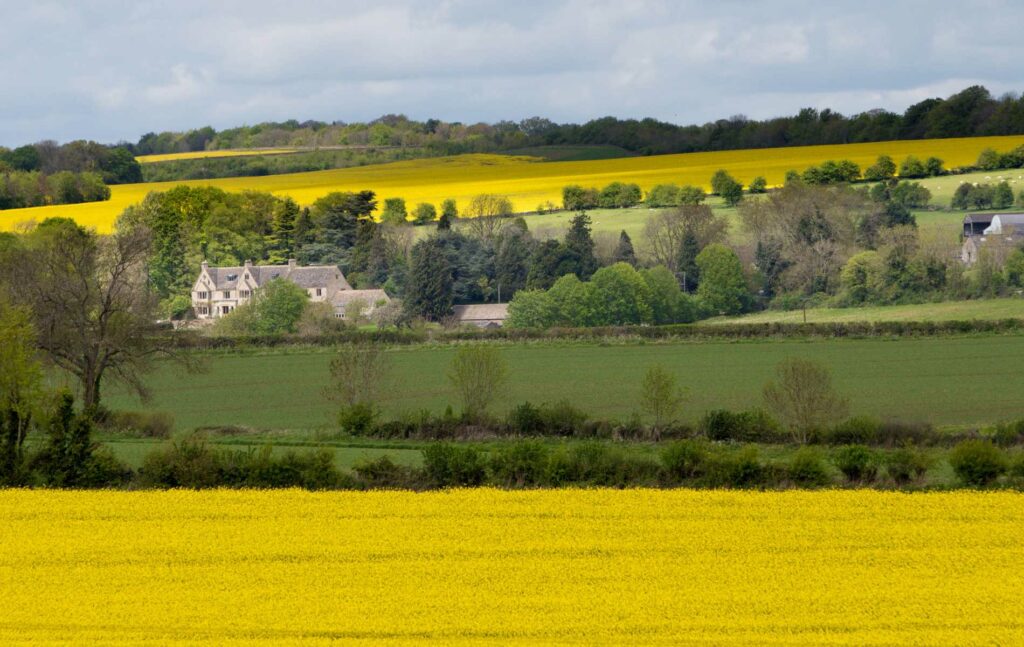
Key facts:
- Education: there are four well-regarded primary schools in the catchment areas for Tisbury, Chilmark, and Teffont Evias. The three state secondary schools are some 15 miles away in the nearby City of Salisbury, where Bishop Wordsworth’s Church of England Grammar School is highly rated. The renowned Godolphin School for girls (3 to 18) is also in Salisbury;
- Transport links: the Nadder Valley runs east from Tisbury until it reaches the River Avon on the outskirts of Salisbury. At the head of the Valley, Tisbury is approximately 13 miles (21 km) to the west of the City. The main A36 trunk road links Salisbury to the M27 and M3 motorways, giving direct access to London by road – the 88-mile (132 km) journey takes around two hours. From Salisbury’s mainline railway station there are around 48 trains a day to London Euston, with the fastest journey time of just one hour and 32 minutes.
Why live in Nadder Valley?
The Nadder Valley has been described as “country living at its most sophisticated”, and has been rated as one of the best places to live in the UK – a recognition that the central village of Tisbury has achieved for four years in a row.
Not only is there the cultured, rural friendliness of the Nadder Valley, but the close proximity of Salisbury (and easy commuting distance onwards to London) keeps the place extremely well-connected.
19. Sherborne, Dorset
Key facts about Sherborne:
- Education: there are three state primary schools in the town of Sherborne, and the main state secondary school (ages 11 to 18), The Gryphon School, all are well regarded. Sherborne is probably most famously associated with its twin independent, fee-paying schools. Sherborne School for Boys has been on the same site for more than 1,300 years, with its alumni achieving the highest ranks of academia, the military, intelligence, diplomacy, and entertainment. Sherborne Girls has the majority of its pupils as boarders (90%) and has a current roll call of 485 girls;
- Transport links: Sherborne is on the main A30 trunk road (between Shaftesbury and Yeovil) but the nearby A303 links to the M3 motorway and, from there, directly into central London. Driving time for the 120-mile (193 km) journey is some two hours and 18 minutes. There are 19 trains a day from Sherborne to London Victoria, with the fastest of them taking just two hours and 19 minutes to reach the capital.
Why live in Sherborne?
A picture-postcard market town of mellow stone, medieval and Georgian houses in north-west Dorset, waxes one description of this settlement situated on the edge of the glorious Blackmore Vale.
Areas of Outstanding Natural Beauty abound and the Jurassic Coast, which stretches for 95 miles from Dorset to East Devon, is but a short drive away. This is English country living at its best – yet the capital is only a relatively short drive or train ride away.
20. Malmesbury, Wiltshire
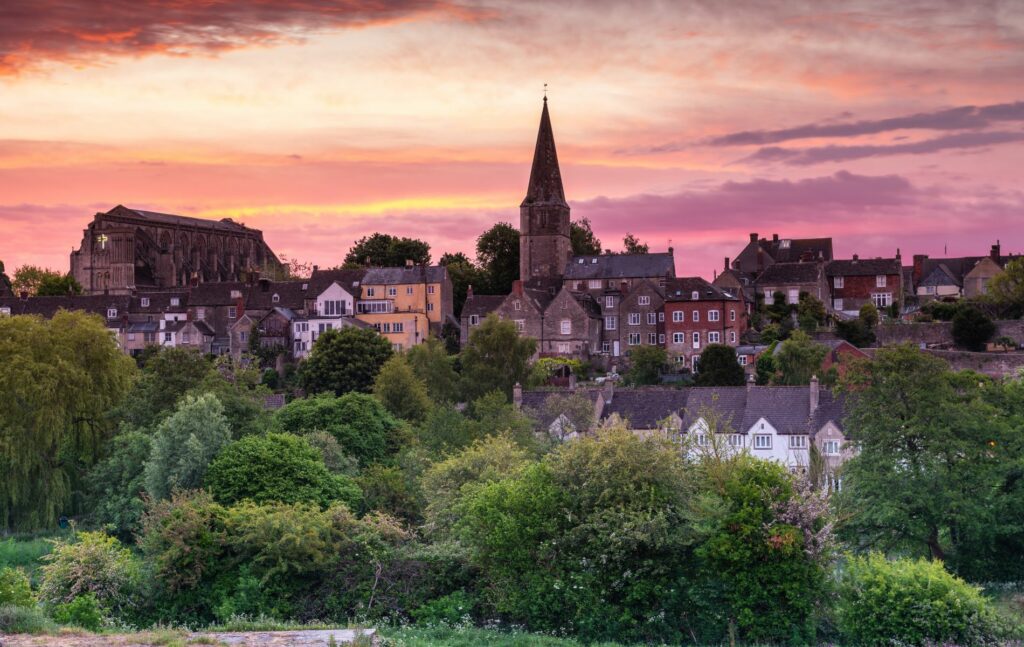
Key facts:
- Education: there are the three primary schools in the town, a notable example is Malmesbury Church of England Primary School. The main state secondary school or academy, Malmesbury School is also highly regarded. Just five miles (eight km) to the north of Malmesbury, in Tetbury, is the highly-rated, independent, co-educational schools (11-18 years) Westonbirt School;
- Transport links: Malmesbury occupies a flat hilltop on the edge of the Cotswolds and is 18 miles (29 km) from a principal junction with the M4 motorway near Swindon. By way of the M4, Malmesbury is 93 miles (150 km) from London – a drive that takes around one hour and 44 minutes. Swindon also has the mainline railway station, where some 165 trains daily take an average of just one hour to reach London Paddington.
Why live in Malmesbury, Wiltshire?
It’s probably a little-known fact that Malmesbury is the oldest borough in England – its history, therefore, is long and illustrious, featuring a famous abbey built in the 12th century.
Today, it is a bustling market town, with prosperous and well-heeled independent shops at the centre of rural and semi-rural lifestyles – but with Swindon offering scope for daily commuting or fast connections by road and rail to London.
Best places to live in the South West of England
As property finders, we often assist clients in deciding where to live in the South West of England based on their requirements and preferences.
If you would like to talk with one of our expert buying agents, please do get in contact with Garrington.
